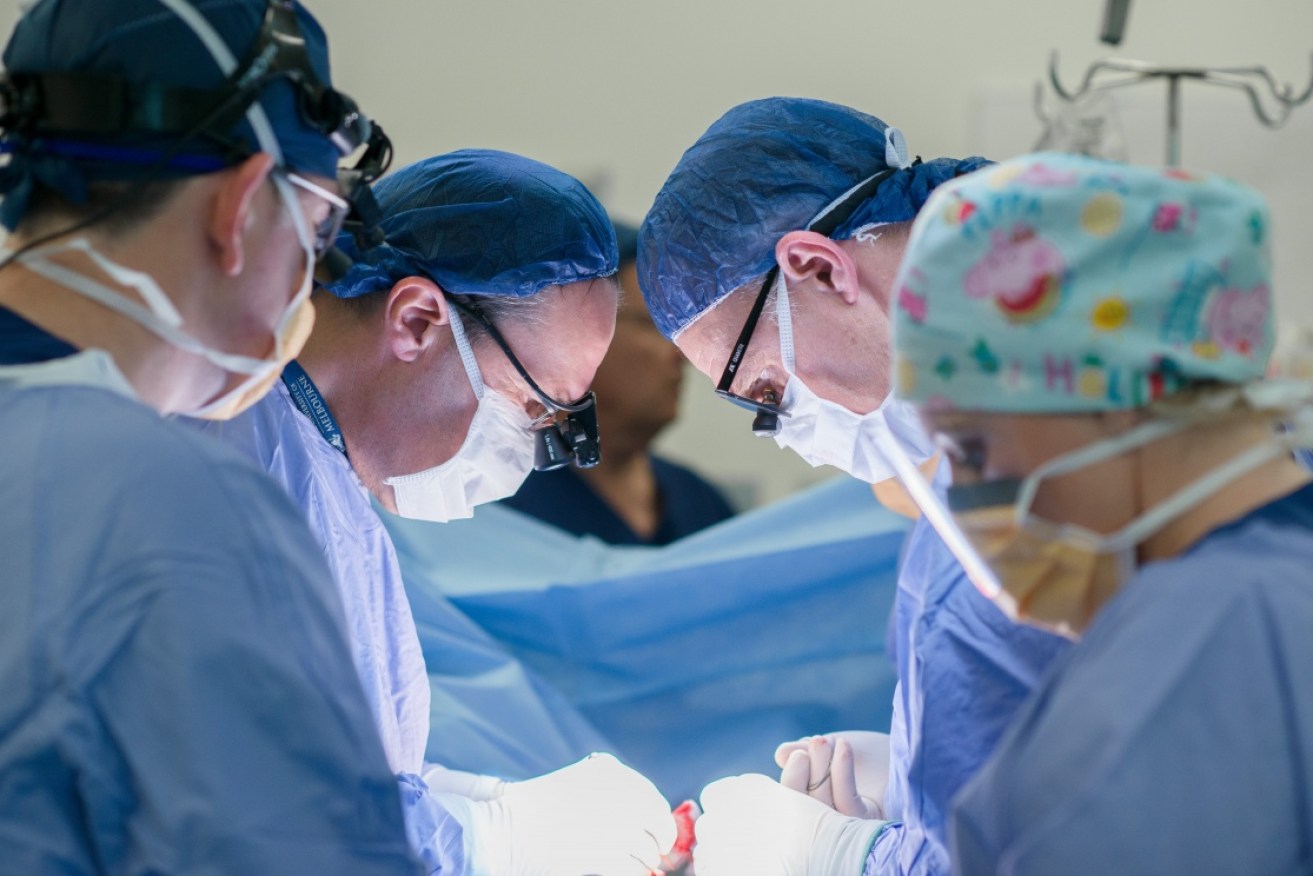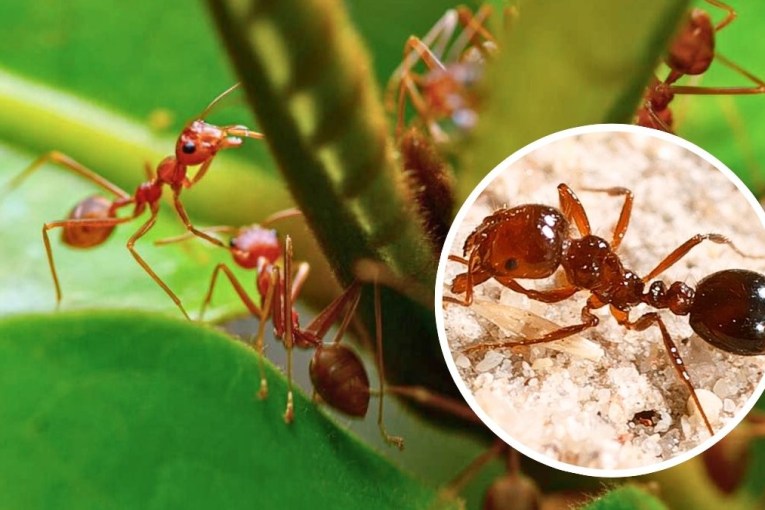The most amazing and controversial medical advances of 2018


All eyes were on the surgeons who successfully separated conjoined twins Dawa and Nima. Photo: RCH Melbourne
Scientists are known for pushing boundaries and this year was no different. From ‘designer babies’ and deadly mozzies turned sterile to microchips for sight, medical researchers have extended the realms of what’s possible in 2018.
Here are some of the most amazing, shocking and sometimes controversial medical advances that caught our attention this year.
Paralysed men walk again after ‘miracle’ implant
After being left paralysed in 2011 by a sporting injury, Swiss spinal injury survivor David M’zee failed to respond to traditional rehabilitation techniques, and doctors told him to prepare for a life spent on wheels.
Today, thanks to a spinal injury breakthrough, he is able to stand and stroll almost one kilometre by Lake Geneva.

Dr Grégoire Courtine shares a laugh with David M’zee (right) and his history-making patients. Photo: BBC
He is one of three men who was able to take their first steps after Swiss doctors implanted a newly developed electronic device that delivered targeted pulses of electricity to specific spinal neurons.
Unlike previous stimulators, which run constantly and sent jolts to all neurons, the team designed a wireless system that continued to work even after the stimulation units were turned off.
The evidence, published in Nature, strongly suggests the electro-stimulation method has helped to regenerate the shattered nerve connections in the body.
Though hailed as a miracle implant, neurologists stressed that the device is still years away from becoming routine treatment.
Bhutanese twins successfully separated in six-hour surgery
Following 15 months of being joined at the torso, conjoined twins Nima and Dawa (whose names mean sun and moon) flew from Bhutan to Australia for a delicate surgery to separate them at Melbourne’s Royal Children’s Hospital.
On November 9, the twins went into surgery at 8.30am and people around Australia and the world held their breath. By 4pm, the hospital’s head of paediatric surgery, Dr Joe Crameri, confirmed the news that everyone had been hoping for, “twins Nima and Dawa are both in a stable condition, and recovering on a ward”, triggering scenes of joy and celebration everywhere.

Separated twins Nima and Dawa leave hospital with their mother, Bhumchu Zangmo. Photo: Nine Network
The King of Bhutan Jigme Singye Wangchuck reportedly shared a special message with the hospital, thanking the hospital for making it possible for “Nima and Dawa to enjoy a happy and meaningful life in Bhutan”.
Conjoined twins are rare (1 in every 200,000 live births), and the success of the separation surgery depends on the organs shared and access to specialised medical teams. In 2016, twin boys Anias and Jadon McDonald born joined at the head were successfully separated in a marathon 27-hour operation in New York.
Cooling ‘brains on fire’ to treat Parkinson’s disease
In November, University of Queensland researchers announced they had developed a world-first pill that appeared to stop Parkinson’s “in its tracks”.
The therapy (MCC950), which is taken once a day, has been found to prevent the loss of brain cells and lead to improved motor function, in a series of animal studies conducted by the UQ Faculty of Medicine researchers.
“MCC950 effectively ‘cooled the brains on fire’, turning down microglial inflammatory activity, and allowing neurons to function normally,” UQ researcher Professor Matt Cooper said.
The drug is now ready for phase-one clinical trials, beginning with a study in healthy volunteers in 2019, then phase-two trials in Parkinson’s patients scheduled for 2020.
Next generation bionic eyes
Ever since the race for the world-first bionic eye ended with a successful transplant in 2015, scientists have been looking at new and improved ways to restore vision in people who could previously see.
Following in the footsteps of Melbourne ear surgeon Graeme Clark who brought us the cochlear implant in the 1970s, Australian researchers are leading the way with a series of world-first, next-generation technologies.
In November, Australian medical device company Bionic Vision Technologies announced that Melbourne researchers had successfully restored a sense of vision using its next-generation bionic eye in four blind people with Retinitis Pigmentosa, the leading cause of inherited blindness. Further north, University of Sydney researchers developed a wireless, microchip implant system called the ‘Phoenix 99 Bionic Eye’, which they hope to trial in humans by next year.
A uterus transplant, a deceased donor and a healthy baby girl
In December, doctors released the details of the first baby who was born after a uterus transplant from a deceased donor. Publishing their results in Lancet, doctors said that the healthy baby girl was born at Brazil’s Hospital das Clinicas last December, weighing in at nearly six pounds.
Though not the first baby born via a uterus transplant (there have been 11 documented cases since 2014), this is the first time in the world that a baby has been born from a deceased donor, and is considered the first successful uterus transplant in Latin America.
The donor recipient was a woman who had ovaries but no uterus.
Doctors said the birth signals a “source of hope” for patients who do not have a uterus, and could help avoid risky live donor transplants.
Designer babies and the CRISPR ‘rogue’
In November, Chinese scientist He Jiankui’s announcement that he had altered the genes of twin girls to make them resistant to HIV infection using CRISPR technology changed the genome editing landscape forever.
His research, yet to be published and performed without official permission, sent shockwaves around the world and led to global condemnation of so-called ‘designer babies’.
Researchers labelled the study as dangerous and unethical, saying it would leave the twins exposed to unknown medical risks.
However, the rogue scientist, who recently made Nature’s 10: People who mattered in science list, said that he felt “proud” of what he had done and his aim was to help people with HIV. The Chinese health ministry has since launched an investigation into the study and He Jiankui is forbidden from continuing his research.
100% human skin graft for safer treatment of burns
For more than 40 years, skin graft cultures for the treatment of severe burns and skin wounds have been made up of part human cells and part mice cells.
Skin cells are normally collected from the patient and grown in cell culture in the lab to form a larger patch of tissue, which is then grafted onto the wounds. Doctors would then add cells from mice to the culture to support this tissue growth, but this can potentially expose patients to infection or a negative immune response from the mice cells.
To eliminate this problem, Singaporean researchers came up with a 100 per cent skin graft cell culture, which uses only human cells. While looking for similar cells in the body, the scientists found a type of protein that can be used instead and has been tested successfully in animal trials.
Mozzies turned sterile to stop spread of disease in operation Debug
In a major win in the battle against disease-spreading mosquitoes, scientists wiped out 80 per cent of one of the world’s most dangerous species, the Aedes aegypti, which can spread deadly infections such as dengue, Zika and chikungunya.
Through an international partnership between CSIRO, Verily and James Cook University, the global Debug project researchers used specialised technology to sterilise around three million non-biting male Aedes aegypti mosquitoes and released them in trial zones along Queensland’s Cassowary Coast. When the sterile males mated with local female mosquitoes, the eggs did not hatch, and their reproduction numbers dwindled dramatically.
The researchers said that the sterile insect technique had been successfully used since the 1950s, but this was the first time they had trialled a mosquito rearing and sex sorting and release technology with such outcomes.








